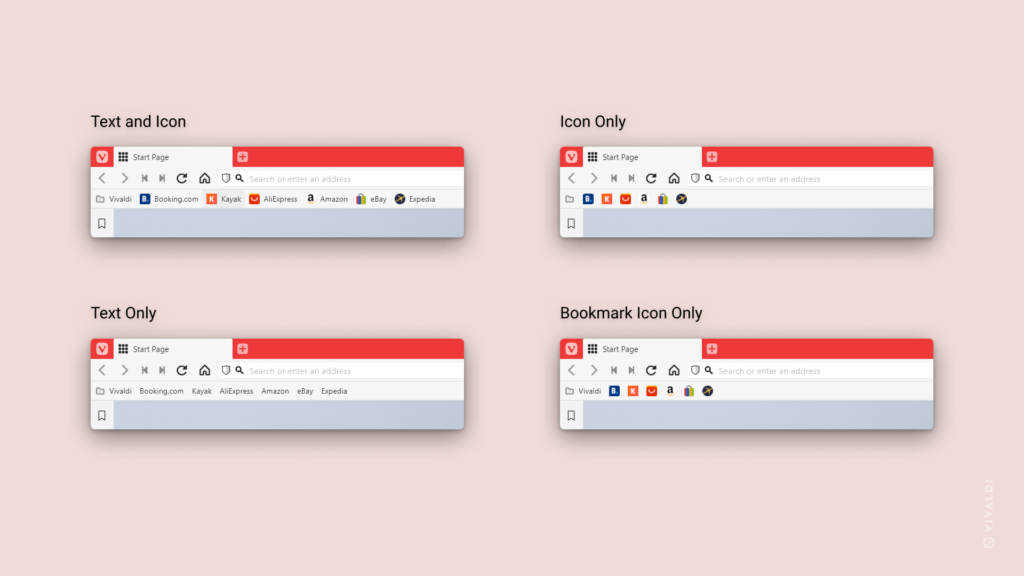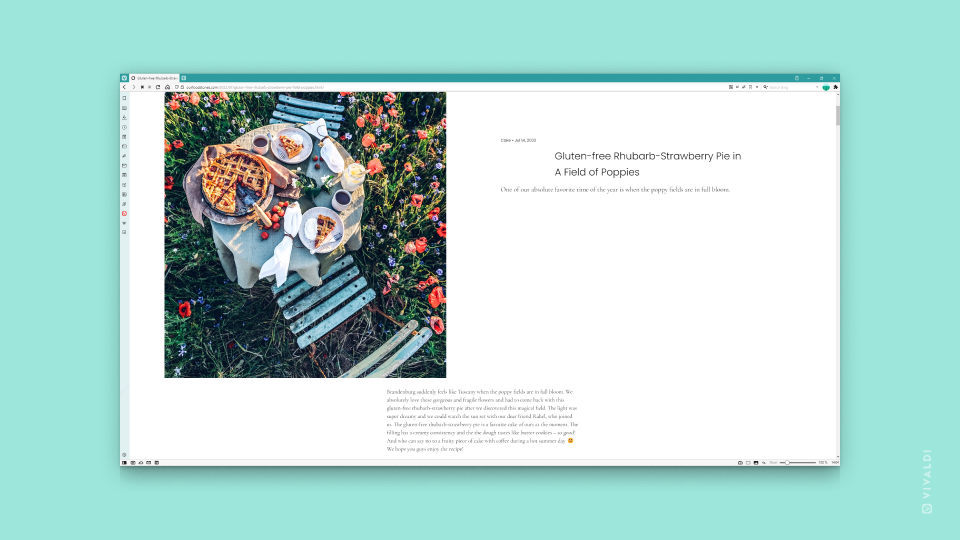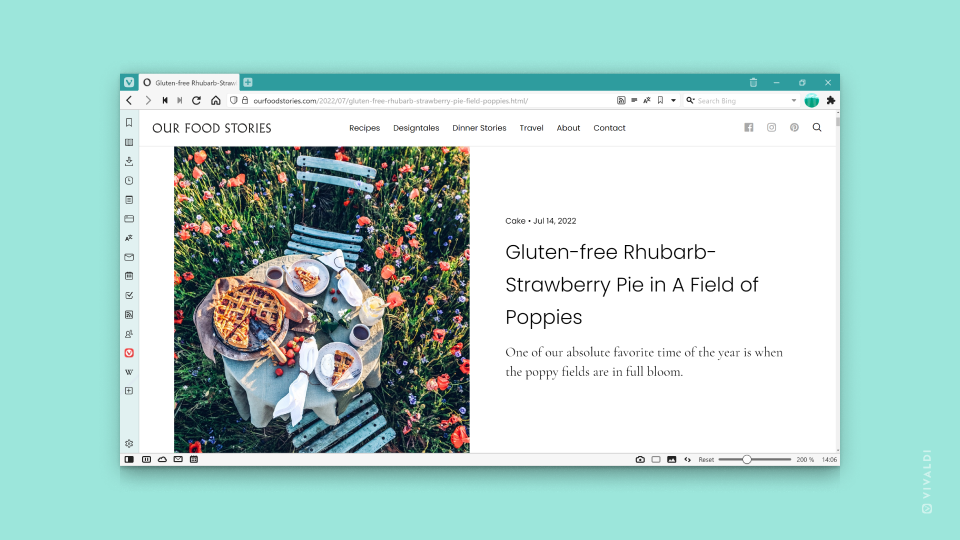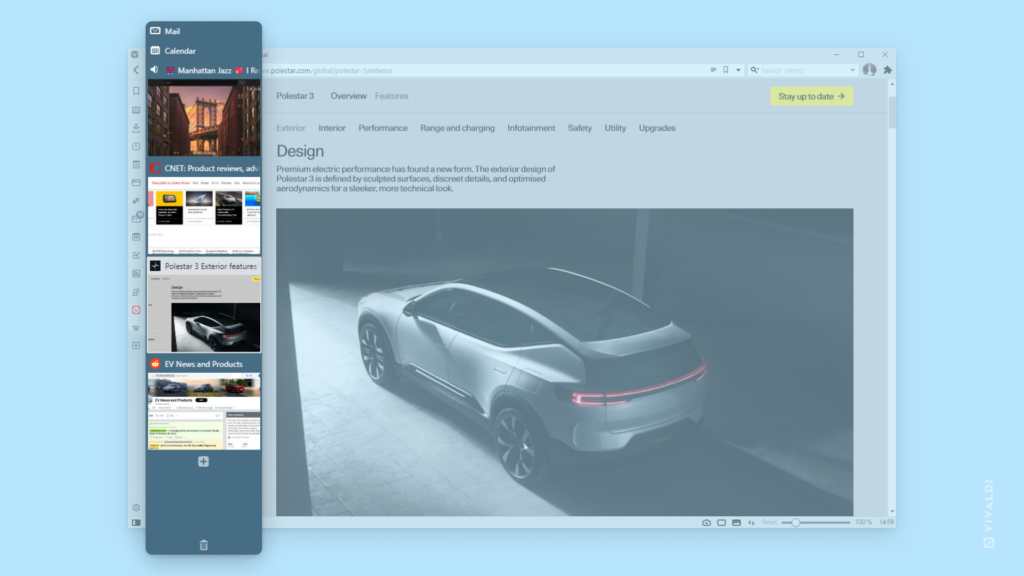Desktop Tips
Tip #139
October 31, 2022
Clean up the user interface by leaving only the important Panels visible.
Many of Vivaldi’s key features, such as Bookmarks, Notes, Mail and your Web Panels, can be accessed from the browser’s sidebar. If you’re not using all these features, consider hiding the Panels you don’t need.
To toggle the visibility of a Panel:
- Right-click on any of the Panels.
- Hover over the Panels option in the context menu.
- Click on the panel you want to hide or show, if you’ve hidden it in the past.
Panels and Web Panels that are hidden don’t have a  check mark in front of their name.
check mark in front of their name.
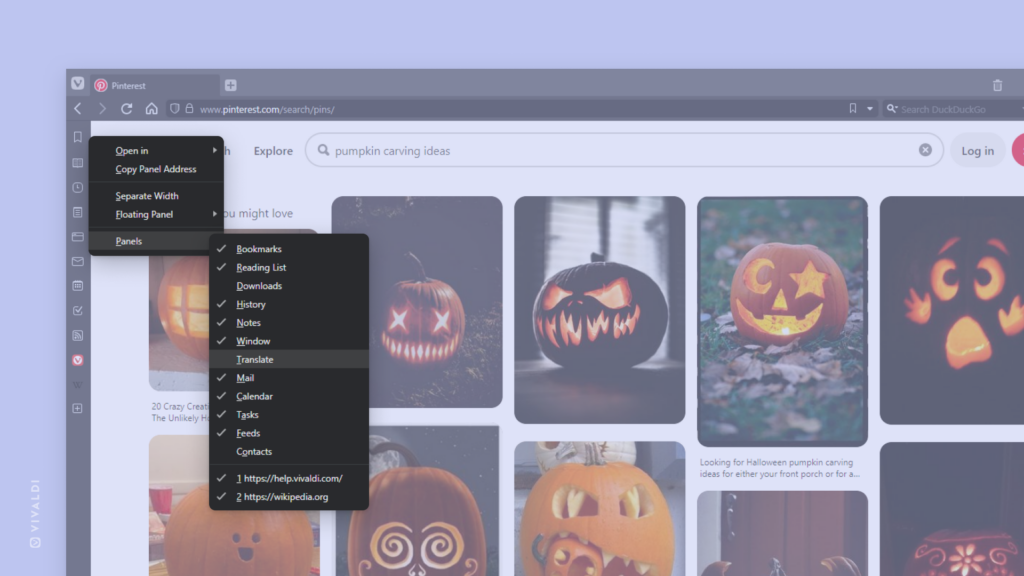
Tip #138
October 28, 2022
If you’re not a fan of the slider, opt for buttons in range controls.
If dragging a slider, for example, to zoom in on a web page doesn’t feel quite right for you, go to Settings > Appearance, enable Use Buttons in Range Control and see if that works better. Then you can do the changes by clicking the + and – buttons.
Range controls are used for the following settings:
- Adjust web page or tab zoom levels in the bottom right corner of the browser window.
- Change the size of the user interface.
- Limit accent color saturation and color contrast in the Themes editor.
- Change active tab’s minimum width on the Tab Bar.
- Choose the delay time for tab stacking when using the drag and drop method.
- Set minimum stroke length for mouse gestures.
- Update default web page zoom.
- Adjust font settings for Reader View.
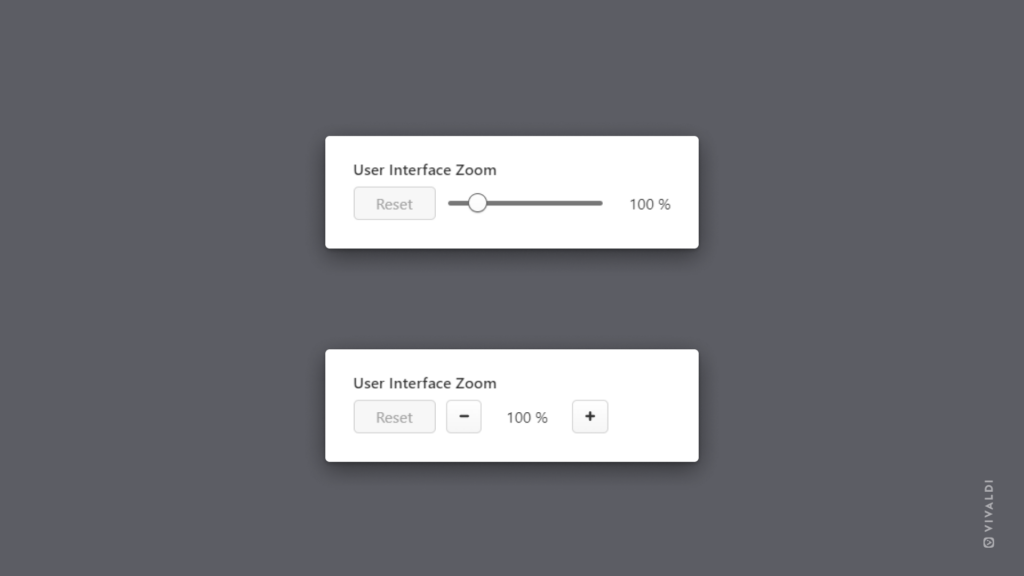
Tip #137
October 27, 2022
Bookmarks can be added to Vivaldi from menus, with shortcuts and more. Find your favorite!
Everyone can find their preferred method of adding bookmarks in Vivaldi. See the list below and try them all to see which ones you like best.
- Click on the
 Bookmark Page button on the right side of the Address Field.
Bookmark Page button on the right side of the Address Field. - Use the Keyboard Shortcut Ctrl+D / ⌘ D.
- Type “Create Bookmark” in Quick Commands.
- Select Add Active Tab in the Bookmark Menu.
- Right-click on the web page and select Bookmark Page from the context menu.
- Right-click on the web page’s tab on the Tab Bar and select Bookmark Tab from the context menu.
- Right-click on a bookmark folder or empty area in the Bookmark Panel or on the Bookmark Bar and select Bookmark Active Page.
- Drag the link (starting from
 Site info button on the Address Bar) to the destination folder in the Bookmark Panel or Bookmark Bar.
Site info button on the Address Bar) to the destination folder in the Bookmark Panel or Bookmark Bar. - Create a Mouse Gesture for the action.
- Add one manually in the Bookmark Panel or Bookmark Manager.
- Click Add New Speed Dial on the Speed Dial on the Start Page to create a Speed Dial bookmark.
- Right-click on an empty area on the Speed Dial and select Add Bookmark to Speed Dial, if you’ve hidden the button Add button.
Tip #134
October 24, 2022
Mail list on the left and message on the right? Or mail list on top and message at the bottom? The choice is yours!
Vivaldi Mail offers 3 layouts for you to choose from. Opt for the one that supports your workflow best.
To switch layouts:
- Go to Settings > Mail > Mail Settings > Mail View Layout;
- Select between:
- Vertical,
- Vertical Wide, and
- Horizontal.
Alternatively, click on the  Toggle View button in the top right corner of the Mail tab.
Toggle View button in the top right corner of the Mail tab.
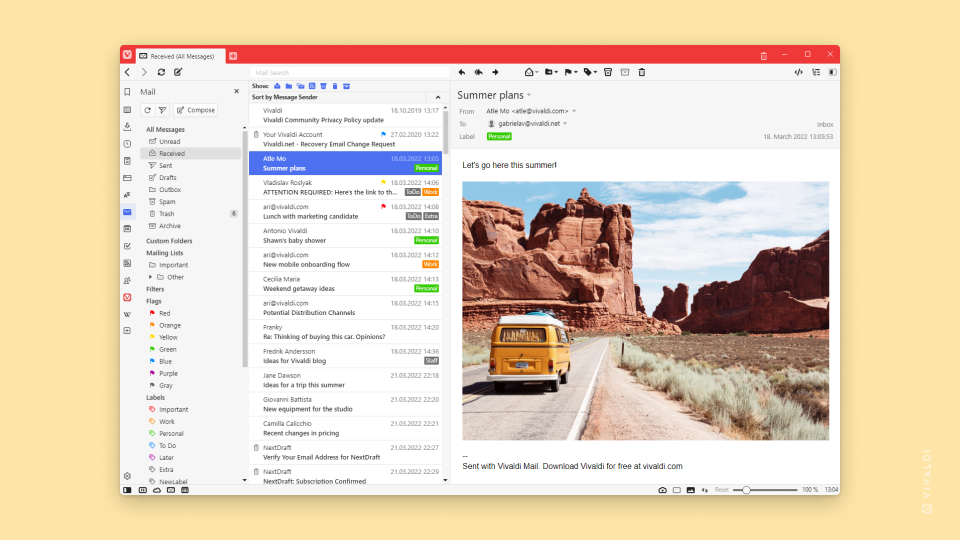
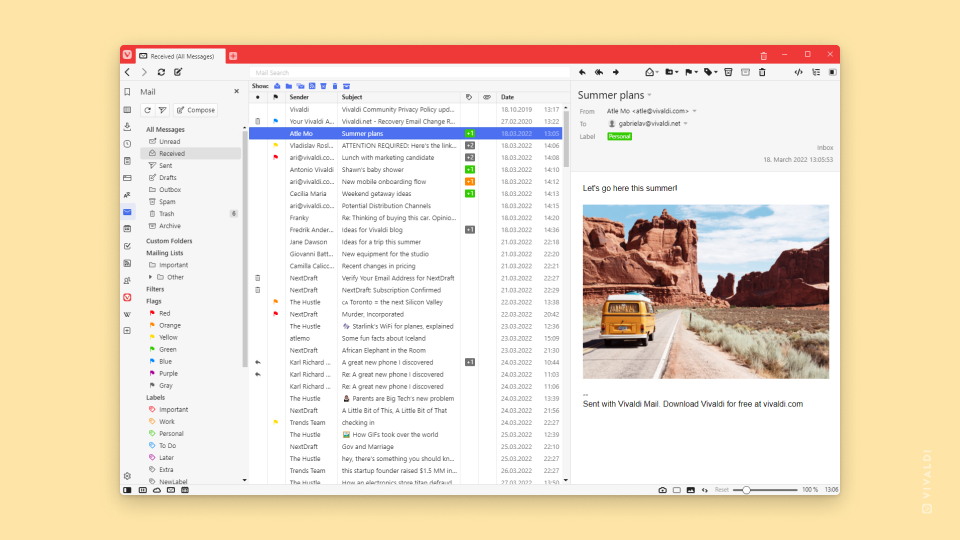
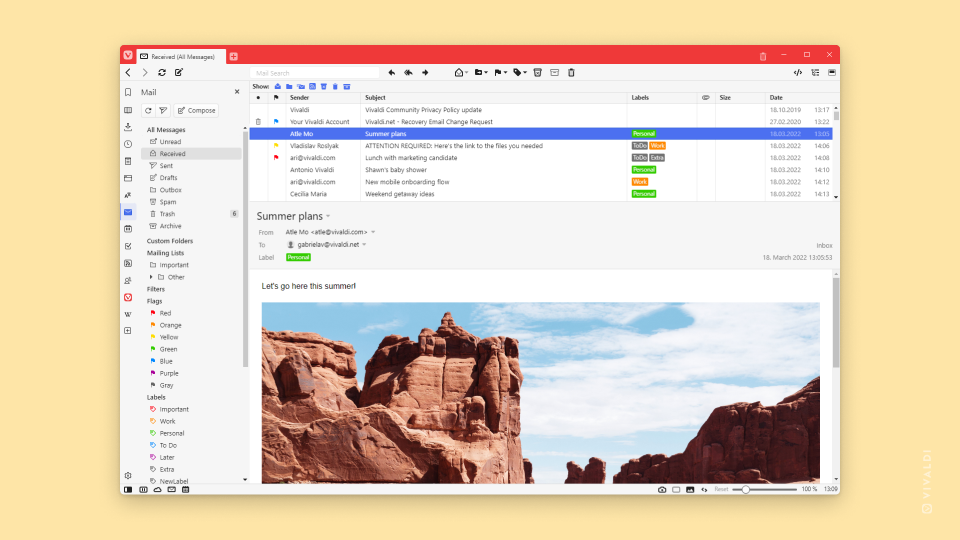
Tip #133
October 21, 2022
Adjust User Interface and Tab zoom for more comfortable browsing.
There’s no need to strain your eyes with Vivaldi. If the buttons on the toolbars are too small and text uncomfortable to read, increase the zoom levels to see them better. If you’d like to make the user interface and webpages smaller, you can do that too.
To adjust user interface zoom:
- Go to Settings > Appearance > Window Appearance > User Interface Zoom.
- Use the slider or + and – buttons to change the zoom level.
To also change the size of the content on web pages.
- Go to Settings > Webpages > Default Webpage Zoom.
- Use the slider or + and – buttons to change the zoom level.
Take a look at the Help page about Zoom options in Vivaldi to learn about other zooming methods.
Tip #132
October 20, 2022
Choose the most relevant output for screen captures.
Vivaldi’s Capture tool is a convenient way to take screenshots of either full web pages or of sections of the page. On Desktop you also have the option to store the capture in your preferred format.
To capture a screenshot:
- Click on
 Capture Page on the Status Bar or use your preferred shortcut.
Capture Page on the Status Bar or use your preferred shortcut. - Select whether you want to capture a small area or the whole page.
- Then select the output format:
- Save as JPG,
- Save as PNG,
- Save to clipboard,
- Create a new note from the capture.
- If you chose to capture a selection, define the capture area.
- Click Capture.
The first two output options will save the file automatically in the location defined in Settings > Web Pages > Image Capture > Capture Store Location. Saving to clipboard allows you to paste the screenshot in a document, chat, etc. without needing to take additional steps. Creating a note will attach the screenshot to a new untitled note, which you can view and edit in the Notes Panel or Notes Manager.
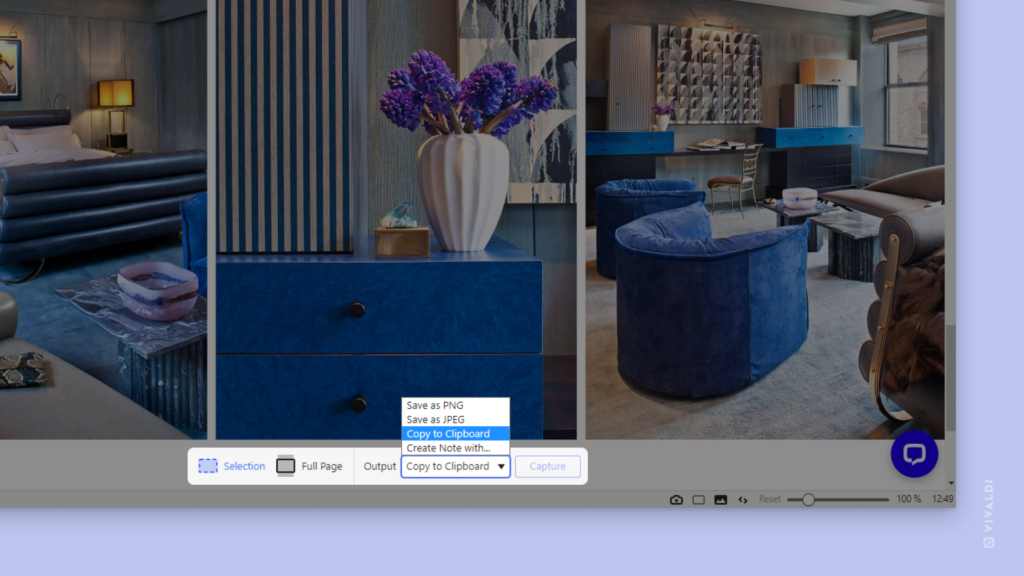
Tip #131
October 19, 2022
Use Shift + arrow keys to navigate between links and elements on web pages.
To focus on the next and previous elements on a web page, you can use the Tab and Shift+Tab keys, respectively. Depending on your goal, that might result in having to press the same key or key combination many, many times.
You can navigate faster through the whole page with just the keyboard using Spatial Navigation. While holding down the Shift key press the arrow keys to move to elements left, right, above and below the currently highlighted element (has an orange border around it). When you’ve focused, for example, on a link on the page, press Enter to open it.
Tip #130
October 18, 2022
Hide lesser used Extensions to declutter the Address Bar.
Vivaldi has an abundance of features that help you rely less on third-party Extensions, but you may still wish to use some extensions. You can declutter the Address Bar by hiding extensions you don’t use very often or don’t need to interact with via their button on the Address Bar.
To hide an extension:
- Right-click on the extension button on the Address Bar.
- Select Hide Button from the context menu.
To show/hide hidden extensions, click on the  Extensions button.
Extensions button.
By default hidden extensions are displayed on the Address Bar. If you wish to see them in a drop-down menu like on the screenshot below, go to Settings > Address Bar > Extension Visibility and enable Expand Hidden Extensions to Drop-Down Menu.
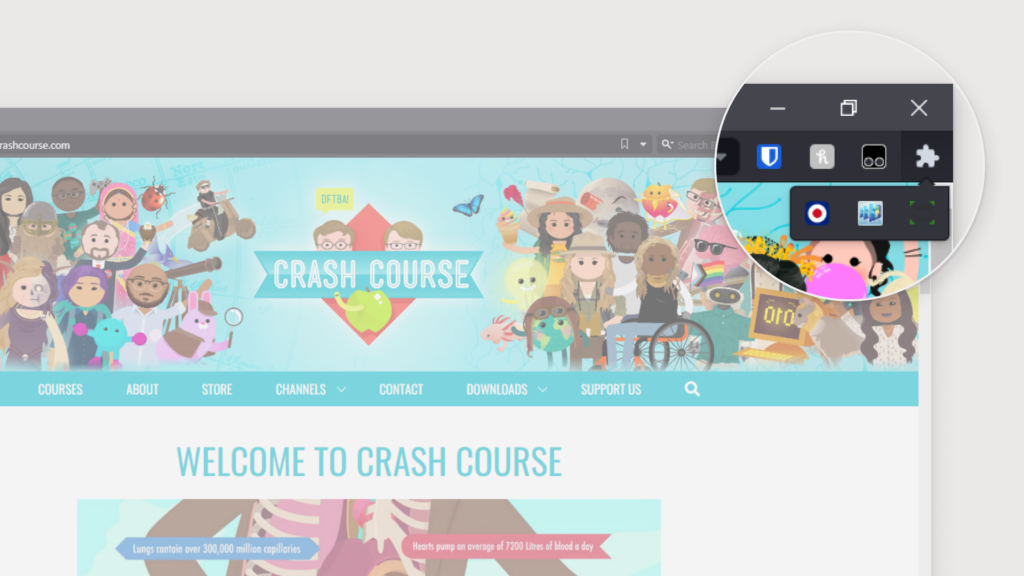
Tip #129
October 17, 2022
Change the visible hours in Vivaldi Calendar to match your average day length.
If you’re an early bird you might want to your days in the Calendar to start earlier too or vice versa, later, if you’re a night owl.
To change the start and end hours and thus also the length of the day:
- Go to to Settings > Calendar > Calendar Display > Visible Day Hours.
- Choose the hours the day starts and ends with.
Then, in Day and Week views, the day starts and ends with your chosen hours. For example, at 4:00 in the morning as on the screenshot below. All hours outside your day will be collapsed. To show collapsed hours as well, untick the box for Collapse Excluded Hours in Visible Day Hours setting.
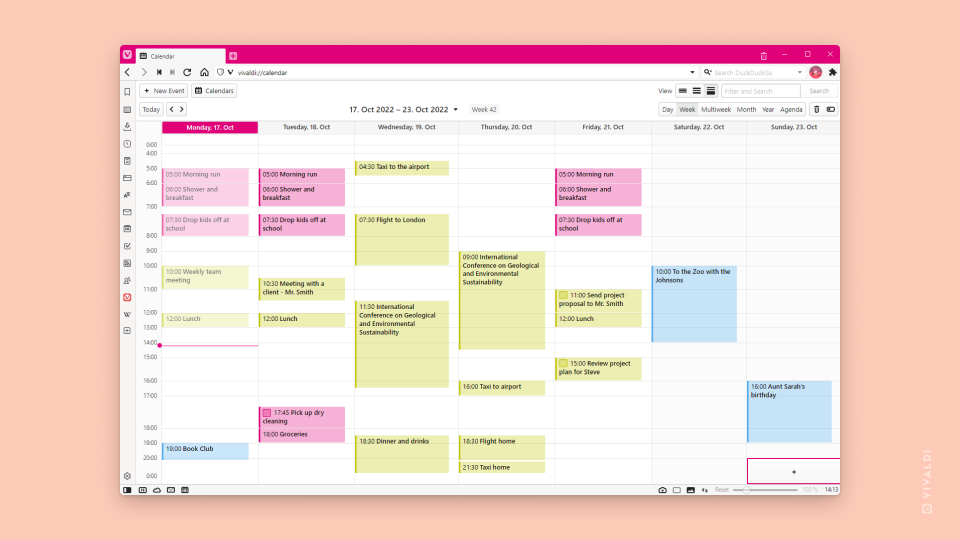
Tip #128
October 14, 2022
Enable Tab Thumbnails to get a visual preview of the Tab’s content.
With a visual preview of tabs on the Tab Bar, it’s easier to find the tab you’re looking for, as you can rely on recognizing the page content in addition to reading tab titles.
To enable Tab Thumbnails:
- Go to Settings > Tabs > Tab Options.
- Enable Show Tab Thumbnails.
In case you have too many tabs open or only sometimes want to see the thumbnails, create a Keyboard Shortcut or a Mouse Gesture to quickly toggle the thumbnails on and off. Alternatively, you can rely on Popup Thumbnails that appear when you hover over a tab.
Tip #127
October 13, 2022
Add empty space to the Address Bar to resize the Address Field.
Address Field takes up all available space that’s left over from buttons and other components on the Address Bar. On a larger screen the Address Field can get quite long. You can resize and center the Address Field by adding empty space on both sides, thus making the Address Field easier to access and the overall look a bit cleaner.
To add space to the Address Bar:
- Go to
 Vivaldi menu > View > Customize Toolbar.
Vivaldi menu > View > Customize Toolbar. - Make sure Navigation Toolbar is selected in the editor.
- Find the Flexible Space component and drag it to both sides of the Address Field.
- When you’re done, click outside the editor window to exit.
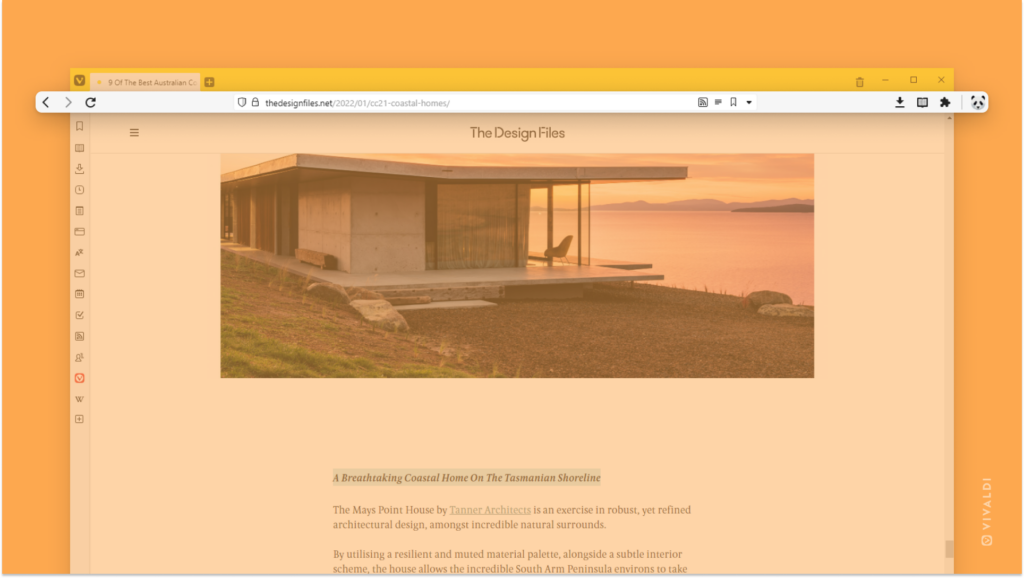
Tip #125
October 11, 2022
Choose how to display bookmarks and bookmark folders on the Bookmark Bar.
One of the fastest ways to access your favorite bookmarks is to display them on the Bookmark Bar. How much is shown about a bookmark is up to you to decide. For example, if you have a lot of bookmarks on the Bookmark Bar, you can save space by not displaying the bookmark name and rely only on the website’s logo to find the one you need.
To change how bookmarks are displayed on the Bookmark Bar:
- Go to Settings > Bookmarks > Bookmark Bar and make sure Show Bookmark Bar is enabled.
- Then, from Bookmark Bar Display setting, select one of the following options:
- Text and Icon – Both the website’s logo and name is shown.
- Text Only – Only the website’s name is displayed.
- Icon Only – Only the logo is shown.
- Bookmark Icon Only – Bookmark folders are displayed with both name and logo, but bookmarks only show the logo.
